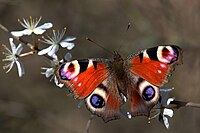
Photo from wikipedia
Selective attention is an important cognitive phenomenon that allows organisms to flexibly engage with certain environmental cues or activities while ignoring others, permitting optimal behaviour. It has been proposed that… Click to show full abstract
Selective attention is an important cognitive phenomenon that allows organisms to flexibly engage with certain environmental cues or activities while ignoring others, permitting optimal behaviour. It has been proposed that selective attention can be present in many different animal species and, more recently, in plants. The phenomenon of attention in plants would be reflected in its electrophysiological activity, possibly being observable through electrophytographic (EPG) techniques. Former EPG time series obtained from the parasitic plant Cuscuta racemosa in a putative state of attention towards two different potential hosts, the suitable bean (Phaseolus vulgaris) and the unsuitable wheat (Triticum aestivum), were revisited. Here, we investigated the potential existence of different band frequencies (including low, delta, theta, mu, alpha, beta, and gamma waves) using a protocol adapted from neuroscientific research. Average band power (ABP) was used to analyse the energy distribution of each band frequency in the EPG signals, and time dispersion analysis of features (TDAF) was used to explore the variations in the energy of each band. Our findings indicated that most band waves were centred in the lower frequencies. We also observed that C. racemosa invested more energy in these low-frequency waves when suitable hosts were present. However, we also noted peaks of energy investment in all the band frequencies, which may be linked to extremely low oscillatory electrical signals in the entire tissue. Overall, the presence of suitable hosts induced a higher energy power, which supports the hypothesis of attention in plants. We further discuss and compare our results with generic neural systems.
Journal Title: Plants
Year Published: 2023
Link to full text (if available)
Share on Social Media: Sign Up to like & get
recommendations!